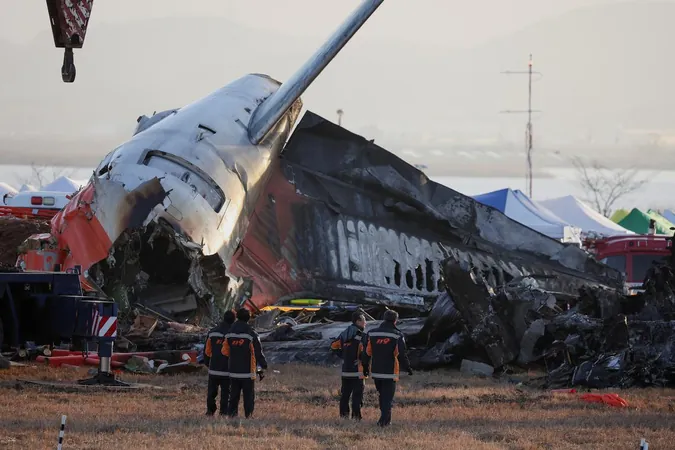
Unraveling the Tragedy: South Korea's Deadliest Air Crash and the Questions that Remain
2024-12-31
Author: Rajesh
SEOUL – Investigation and Urgent Responses
As the investigation into the devastating crash of a Jeju Air jetliner continues, questions are mounting about the circumstances surrounding the disaster that led to the deaths of 175 passengers and crew members. The incident marks the deadliest plane crash in South Korean history, prompting an urgent response from authorities and heartfelt pleas from grieving families seeking answers.
Identification Efforts
In a coordinated effort, the National Police Agency has deployed additional personnel and rapid DNA analysis technology to expedite the identification of victims. As of December 31, five bodies remained unidentifiable, creating a sense of urgency among family members gathered at Muan International Airport, the crash site.
Details of the Crash
The tragedy unfolded on December 29, when a Boeing 737-800 operated by Jeju Air belly-landed, skidded off the runway, and collided with a concrete embankment, resulting in a catastrophic fireball. While two crew members survived, the loss of life was heartbreaking, leaving families devastated.
Government Response and Safety Inspections
In the wake of this crisis, South Korea’s acting President Choi Sang-mok has ordered comprehensive safety inspections for the nation’s airlines. Investigators are meticulously scrutinizing the flight recorder, known as a 'Black Box,' which was recovered but reportedly missing vital components. Transport Ministry officials confirmed that a crucial connector linking the data storage unit to the power unit is absent, complicating efforts to retrieve essential information from the flight data recorder.
Inspection of Aircraft
Efforts to inspect all 101 Boeing 737-800 aircraft operated by South Korean airlines are underway, with completion expected by January 3. Muan International Airport has been closed until January 7, further emphasizing the gravity of the situation.
International Involvement
International experts have joined the investigation, including representatives from the U.S. National Transportation Safety Board (NTSB), Federal Aviation Administration (FAA), and aircraft manufacturer Boeing. NTSB board chair Jennifer Homendy indicated that a team of specialists is on the ground in South Korea, ready to assist and expand resources if necessary.
Potential Factors and Runway Design Concerns
Investigators are delving into several potential factors contributing to the crash, including bird strikes, the possibility of disabled control systems, and the pilots' apparent urgency to land shortly after declaring an emergency. Furthermore, there are significant concerns regarding the design of the airport's embankment structure, which some experts argue is too close to the runway’s end, making the impact of the crash much more severe.
Expert Opinions on Runway Safety
John Cox, a former 737 pilot and CEO of Safety Operating Systems, remarked on the runway design, stating that it did not adhere to industry best practices, specifically the guidelines against placing hard structures within 300 meters of the runway's end. The analysis of satellite images suggests the embankment, built to support navigation equipment, is actually about 250 meters away, far closer than advisable.
Condolences and Global Reactions
As the investigation unfolds, tragic stories are surfacing, and the world stands by the families affected by this incident. Singaporean leaders have expressed their condolences, with Prime Minister Lawrence Wong reaching out to South Korea's government and reiterating Singapore's solidarity during this difficult time.
Remaining Questions and the Future of Aviation Safety
The questions remain: What truly led to this tragedy, and what industry-wide changes will emerge from this heartbreaking event? As the investigation continues, all eyes are on South Korea and its aviation safety protocols.
 Brasil (PT)
Brasil (PT)
 Canada (EN)
Canada (EN)
 Chile (ES)
Chile (ES)
 Česko (CS)
Česko (CS)
 대한민국 (KO)
대한민국 (KO)
 España (ES)
España (ES)
 France (FR)
France (FR)
 Hong Kong (EN)
Hong Kong (EN)
 Italia (IT)
Italia (IT)
 日本 (JA)
日本 (JA)
 Magyarország (HU)
Magyarország (HU)
 Norge (NO)
Norge (NO)
 Polska (PL)
Polska (PL)
 Schweiz (DE)
Schweiz (DE)
 Singapore (EN)
Singapore (EN)
 Sverige (SV)
Sverige (SV)
 Suomi (FI)
Suomi (FI)
 Türkiye (TR)
Türkiye (TR)
 الإمارات العربية المتحدة (AR)
الإمارات العربية المتحدة (AR)